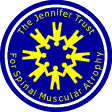The Jennifer Trust for Spinal Muscular Atrophy
  |
An Overview of
|
  |
An Overview of
|
The critical region in 5q13 contains several genes including the Survival Motor Neurone Gene (SMN), the Neuronal Apoptosis Inhibitory Protein gene (NAIP) and the p44 gene. Deletion of NAIP and p44 is observed more often in severe SMA but there is no evidence that these genes play a direct role in the pathology of the disease. NAIP may offer a protective effect to the motor neurones but further research needs to be done in this area before there is any certainty.
There are two copies of the SMN gene, a centromeric copy (SMNcen) located centrally on the chromosome and a telomeric copy (SMNtel) located near the tip of the chromosome. The SMN protein is the product of the SMN genes and is found in the cytoplasm and the nucleus. The nuclear form is located in structures called gems. It is thought that it is the telomeric copy of the SMN gene that plays a major role in disease determination as in over 90% of patients (irrespective of disease severity), there are deletions in both copies of SMNtel.
In addition to SMNtel, the number of copies of the SMNcen gene is thought to play a major role. It is now possible to determine the number of copies of SMNcen and the severity of the disease has been shown to correlate very well with the number of copies of SMNcen. The number of copies would affect the amount of SMN protein produced, i.e. the less the protein the more severe the disease.
SMN protein levels and gem numbers (nuclear form) correlate well, with low gem numbers being found in SMA Type I patients and higher numbers in Types II and III.The number of copies of the SMNcen gene may vary on each allele further complicating the inheritance pattern. An allele is one of a pair or multiple forms of a gene located at the same locus (position) on homologous chromosomes. This may help explain why we see children with differing severity in one family. One sibling may have inherited an allele with several copies of the SMNcen gene and have a milder form than a sibling who inherits an allele with a low copy number of the SMNcen gene.
In summary, the severity of the disease appears, at present, to be a combination of the following factors : -
Unfortunately this is not the final picture as the disease can not be unequivocally explained by the above. Patients have presented with a typical SMA but on analysis have been found to have two copies of the SMNtel gene, although this is a rare event. There is also an adult form of SMA and an autosomal dominant form which do not clearly fit into the above pictiure. There may well be additional factors that play a role and scientists world wide are collaborating to try to explain fully the disease mechanism.
Carrier testing.
Carrier testing is being set up in the UK, but is as yet not available. It is performed in some United States laboratories. It is based on the fact that if there is a homozygous deletion of SMNtel (i.e. 0 copies of the gene) then you have a 95% chance of being a carrier. Conversely if you perform a carrier test and find two copies of SMNtel there is a 90% chance of not being a carrier. There is, however, a small error rate involved.
Current status of therapeutic trials.
At present there are no clinical trials outside the USA. There have been a couple of small Phase I trials using growth factors which proved unsuccessful due to the fact that the patient's body formed antibodies to the growth factor. As a consequence the growth factor would be destroyed in any future contact and Phase II trials never took place.
There is a small trial on the use of Riluzole for SMA Type I patients which began in the USA in April 1998. Results from this will take at least another year but it is thought unlikely to have any benefit.
Gabapentin trial in the USA :
The European Neuromuscular Centre (ENMC) drew up the protocols for this trial and have thus been involved. However, no patients from Europe will be included in this study unless initial results are positive. Clinicians and scientists in Europe think it unlikely that Gabapentin will work, but one positive thing from this trial is that the protocols set up for therapeutic trials will have been tested and, if future trials are planned, these can be implemented.
Gabapentin and Riluzole are glutamate inhibitors which are hypothesised to play a role in Motor Neurone Disease but there is no proven link with SMA.
I have just attended the ENMC workshop on SMA in the Netherlands and it was very encouraging to see scientists and clinicians coming together and collaborating to try to elucidate the mechanisms involved. This type of collaborative research can only benefit families.
What follows will give you an idea of what key scientists are working on in the field of SMA (European and a few Americans). Those listed here are only those who were present, or mentioned, at the ENMC meeting in April 1998. If you feel that there is another project which might be included on this list, please e-mail it to the page editor for consideration.
|
HTML by DanE
First published by The Jennifer Trust for Spinal Muscular Atrophy : 18th May 1998
Latest update : 1st february 2000